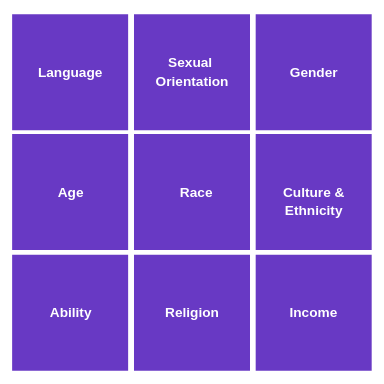Appendix 1: Develop a Framework for Inclusive Governance
Building an inclusive culture within your organization starts with your governance board. Building a culture of inclusion goes beyond ‘tokenism’ where individuals from under-represented groups are recruited to fulfill a quota or prevent criticism. To build a culture of inclusion you need to normalize difference and accommodate for it so that each person feels like they have a right to come to the table, that they have an equal voice and an equal right to speak. Often diversity becomes a code word for ‘race’ or ‘culture’ but there are many intersecting ways that people are pushed to the margins and given less access to power and privilege around board tables.
Although there are many kinds of differences among people, the diagram below shows differences linked to structural inequalities. [1]

Questions to frame your conversations about board diversity and inclusion
The following questions and considerations may be helpful to guide your initial conversation about inclusion and how to build a culture of inclusion within your board. These are questions that invite your board members to think about the relationship between diversity and inclusion, about the good work that they have been engaged in, and also about the work ahead. You can use them as part of a visioning session as the board seeks to determine its next steps or as a way to start the conversation about inclusion.
- What is our understanding of diversity? What kind of diversity exists on our board? Have we completely acknowledged that diversity, or have we been looking at diversity as fulfilling a ‘checklist’ of particular identities (e.g., race or culture)?
- Why are diversity and inclusion important to our organization?
- What is our board’s understanding of privilege and how does it impact interactions on the board? Has the concept of privilege informed the conversation about diversity and inclusion?
- In what ways do you think our board has adopted inclusive practices ? (Ask members to share specific examples.) Possible topics for discussion are: What assumptions underlie our current practices for board terms, orientation and meetings? What assumptions have we been making about individual and collective responsibilities for participation in board meetings?
- How do you feel our board could more effectively create a welcoming and inclusive environment for both new and current members? (Ask members to share specific examples and incorporate assumptions that surfaced in the previous question.)
- Whose voices and perspectives were most represented in the major decisions our board made over the past year (two years)? Whose voices were missing?
- Have changes in board membership to reflect more diversity resulted in changes to decision-making? Why or why not?
- Are there board structures such as policies and procedures or unwritten rules that embed inequity in our board? What are they? What can we do to change them?
- If we imagined our board as a place that was welcoming and inclusive, a place where difference was valued and contributed to the successful working of the board, what would our board look like? What would need to change? What are some of the steps that you think we would need to take to get there? (Be as specific as possible.).
- Adapted from Alberta Urban Municipalities Tool (2014). ↵
